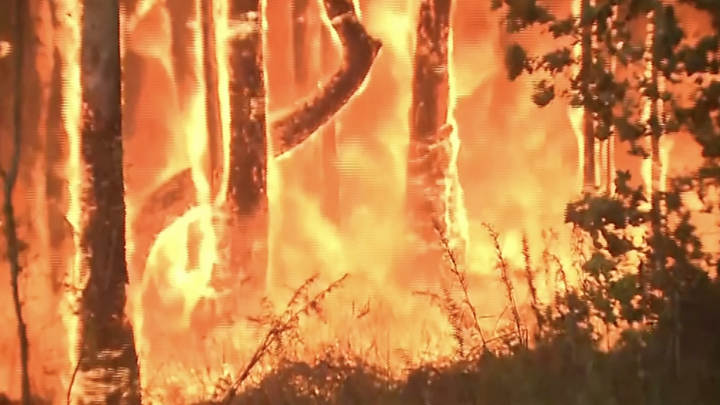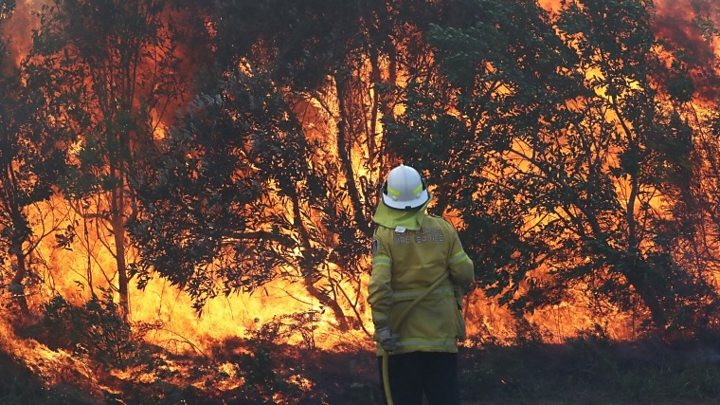[ad_1]

Media playback is unsupported on your device
A vast area of Australia’s east coast – including parts of the Sydney suburbs – is facing one of the nation’s worst-ever bushfire threats.
More than 85 fires are burning across the state of New South Wales (NSW), 46 of which are not contained.
Authorities had predicted “catastrophic” conditions for Tuesday, amid fears a southerly wind could cause the flames to change direction.
About six million people live in the region.
Firefighting planes dropped flame retardant over trees and homes in the suburb of South Turramurra, on Sydney’s north shore, as the bushfires came within 15km (nine miles) of the city centre.
“Next thing I know the fire was opposite our house and it was massive and the police came and grabbed our kids and took them away,” resident Julia Gretton-Roberts told AFP news agency.
“My daughter is pretty freaked out.”
Authorities said the Turramurra fire had been brought under control, but one firefighter battling the blaze there had suffered a broken arm and suspected fractured ribs.
Image copyright
EPA
A firefighter works to contain a fire near Taree, New South Wales
State Premier Gladys Berejiklian, who has declared a seven-day state of emergency, said Tuesday would be “about protecting life, protecting property and ensuring everybody is safe as possible”.
People in vulnerable NSW communities have been urged to stay away from bushland, and to flee their homes before the fires escalate. More than 600 schools are closed across the state.
How bad are the fires?
Three people have died and more than 150 properties have been destroyed since the fire emergency intensified in NSW on Friday.
But authorities said they were now facing what could be “the most dangerous bushfire week this nation has ever seen”.
There are 14 fires burning at emergency level across the state.
Image copyright
AFP/Getty Images
Residential areas of Sydney have been doused in fire retardant as flames menace homes
Experts have compared Tuesday’s forecast to the 2009 Black Saturday bushfires in Victoria, when 173 people died.
It’s the first time that a “catastrophic” level fire warning has been in place across the greater Sydney area and in the regions to the city’s north and south. The highest level rating was brought in after the 2009 disaster.
“Under catastrophic conditions, fires that start and take hold will grow and develop extremely quickly and become large fires very, very easily,” Commissioner Shane Fitzsimmons said.
EPA
-
.the highest point on Australia’s six-point fire danger scale
-
.results from high temperatures, strong winds and dry ground
-
.fires starting under these conditions will threaten lives
-
.homes cannot be defended from catastrophic fires
-
.the only survival advice is to leave at risk areas early
Source: Australian government
What has happened so far?
At least 11 emergency warnings had been issued by 15:00 local time (04.00 GMT), warning people their lives were in imminent danger.
But fire chiefs said the worst was yet to come, with forecasts of up to 37C (98F) in some areas and possible late changes in wind direction.
Crews are battling a front spanning 1,000km (620 miles) along the north coast of NSW, with several blazes “exceeding 100,000 hectares alone”, officials said.
Embers from those bushfires could cause spot fires as far as 30km away, they predicted.
Mr Fitzsimmons said 3,000 firefighters were on the front lines, boosted by crews from other states and New Zealand, as well as the Australian Defence Force.
Earlier reports that a firefighter had suffered a cardiac arrest in North Rothbury, in the Hunter Region of NSW, were a false alarm, the fire chief added.
“It was a case of severe heat stroke and smoke inhalation and the firefighter had collapsed. That firefighter has been treated and is being transported for appropriate attention,” he said.
Police are investigating reports that the North Rothbury blaze, and at least two others, may have been started deliberately.
Carol Sparks – mayor of Glen Innes, a hard-hit region – said the day would get increasingly “volatile and unpredictable”.
“We’re expecting more tragedies in the area,” she told the BBC on Tuesday. “We’ve had loss of life in our little community just east of Glen Innes, and we’re all devastated by this.”
Image copyright
Reuters
Locals try to put out ember-generated fires in New South Wales
Fire authorities said a million hectares of land had been burned in New South Wales since the fire season began in September.
In the small town of Wauchope, 250 miles (400km) north of Sydney, resident Neil Coombes said his home was in the path of an oncoming blaze.
“My wife went home earlier and said, ‘is there anything you want me to get?’,” he told Reuters.
“I said, ‘yes, I want you back here with me.’ If the house burns it burns, but I can’t replace her.”
What about other states?
To the north, Queensland has also declared a state of emergency as 55 bushfires rage in the state.
Though it was not facing such severe weather on Tuesday, officials warned conditions could deteriorate later in the week.
Fire crews in South Australia were tacking about a dozen blazes, while bushfires in Western Australia also sparked emergency warnings.
Is this linked to climate change?
Scientists and experts warn that Australia’s fire season has grown longer and more intense due to climate change.

Media playback is unsupported on your device
Officials have confirmed that 2018 and 2017 were Australia’s third and fourth-hottest years on record respectively, and last year the nation experienced its warmest summer on record.
The Bureau of Meteorology’s State of the Climate 2018 report said climate change had led to an increase in extreme heat events and raised the severity of other natural disasters, such as drought.
Even if global temperatures are contained to a 2C rise above pre-industrial levels – a limit set out in the landmark Paris accord, agreed by 188 nations in 2015 – scientists believe the country is facing a dangerous new normal.
Last year, a UN report said Australia was falling short in efforts to cut its CO2 emissions.
Have you been affected by the bushfires? Share your experiences by emailing haveyoursay@bbc.co.uk.
Please include a contact number if you are willing to speak to a BBC journalist. You can also contact us in the following ways:
- WhatsApp: +44 7756 165803
- Tweet: @BBC_HaveYourSay
- Text an SMS or MMS to 61124 or +44 7624 800 100
- Please read our terms of use and privacy policy
[ad_2]
Source link
